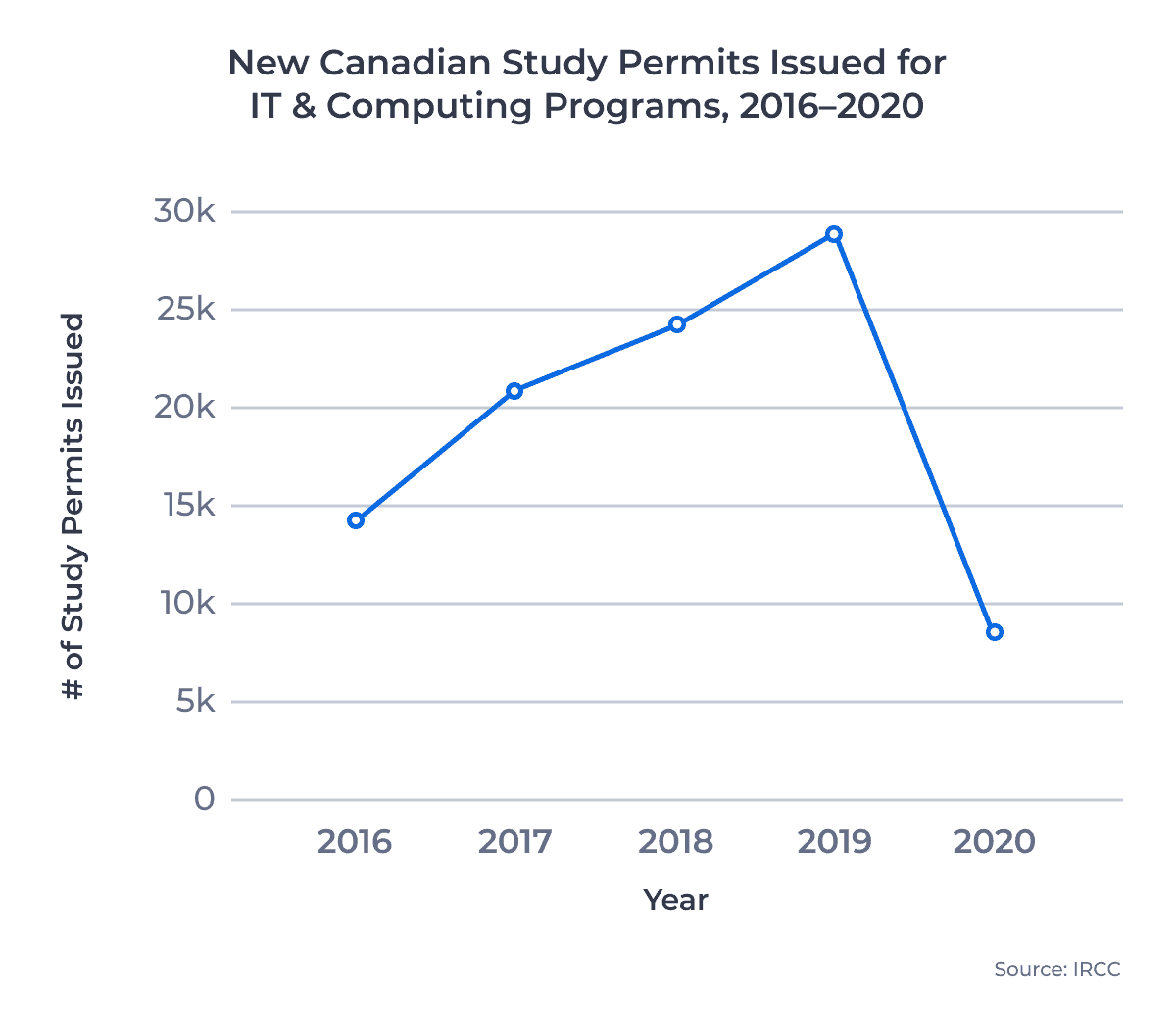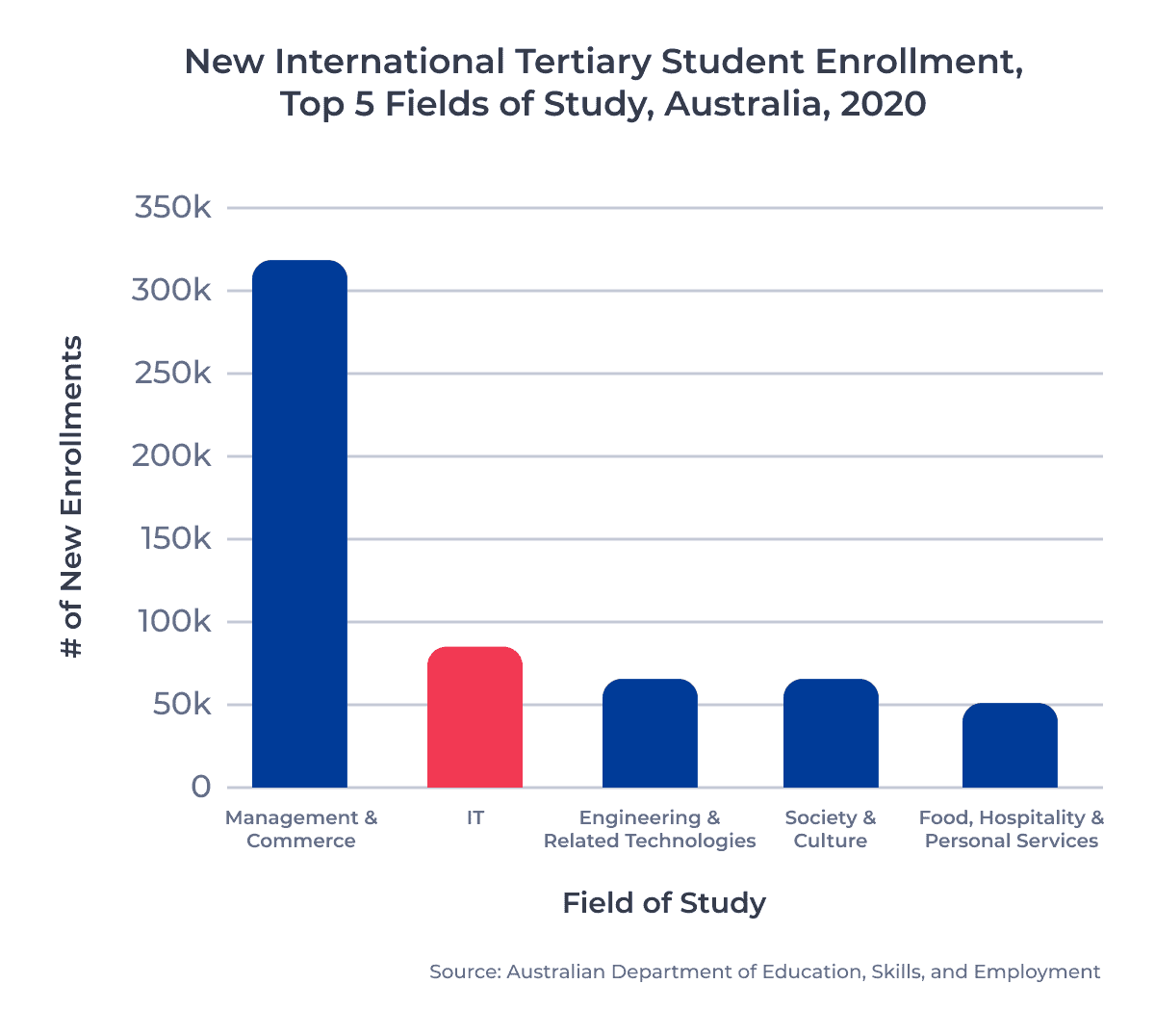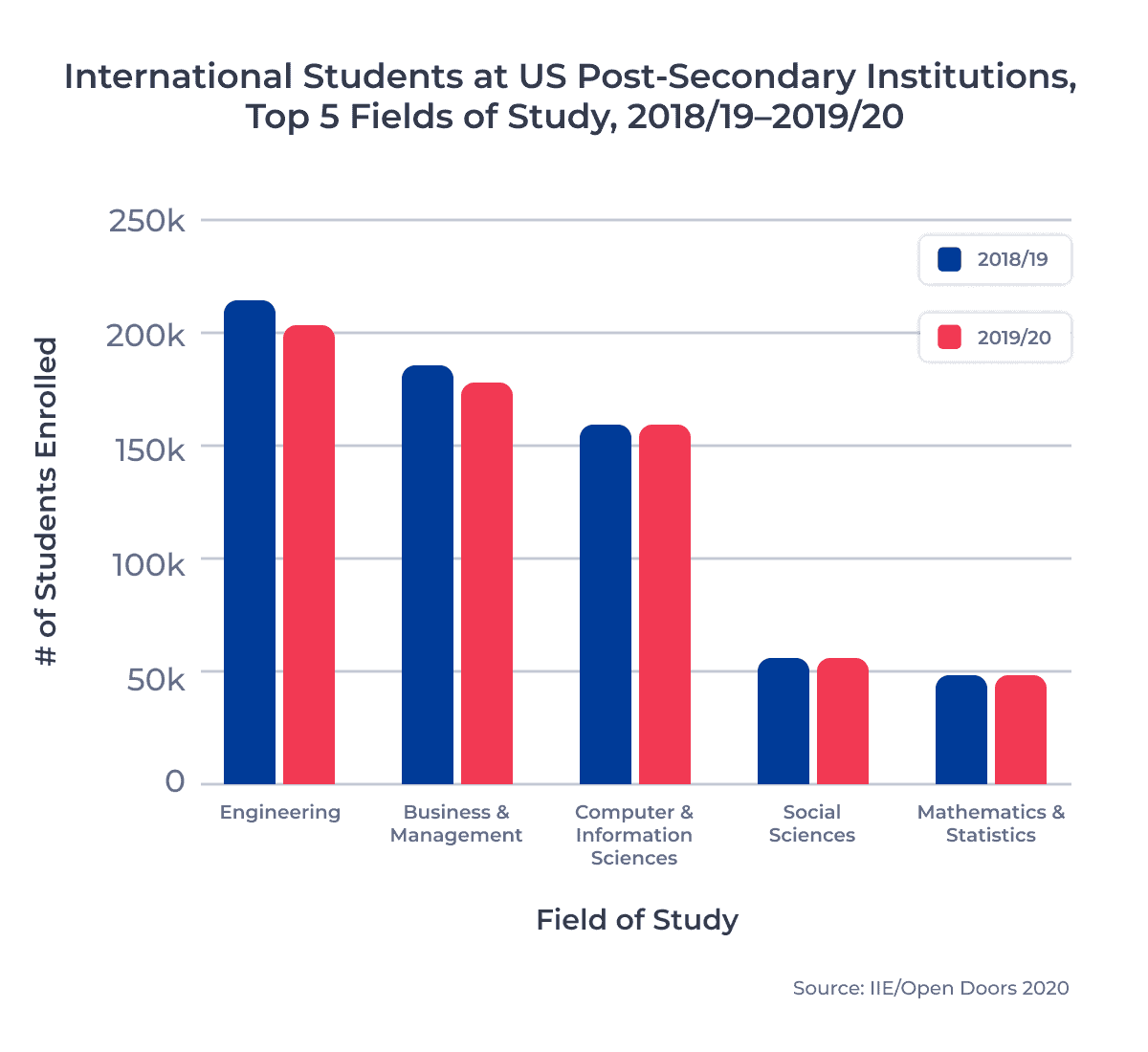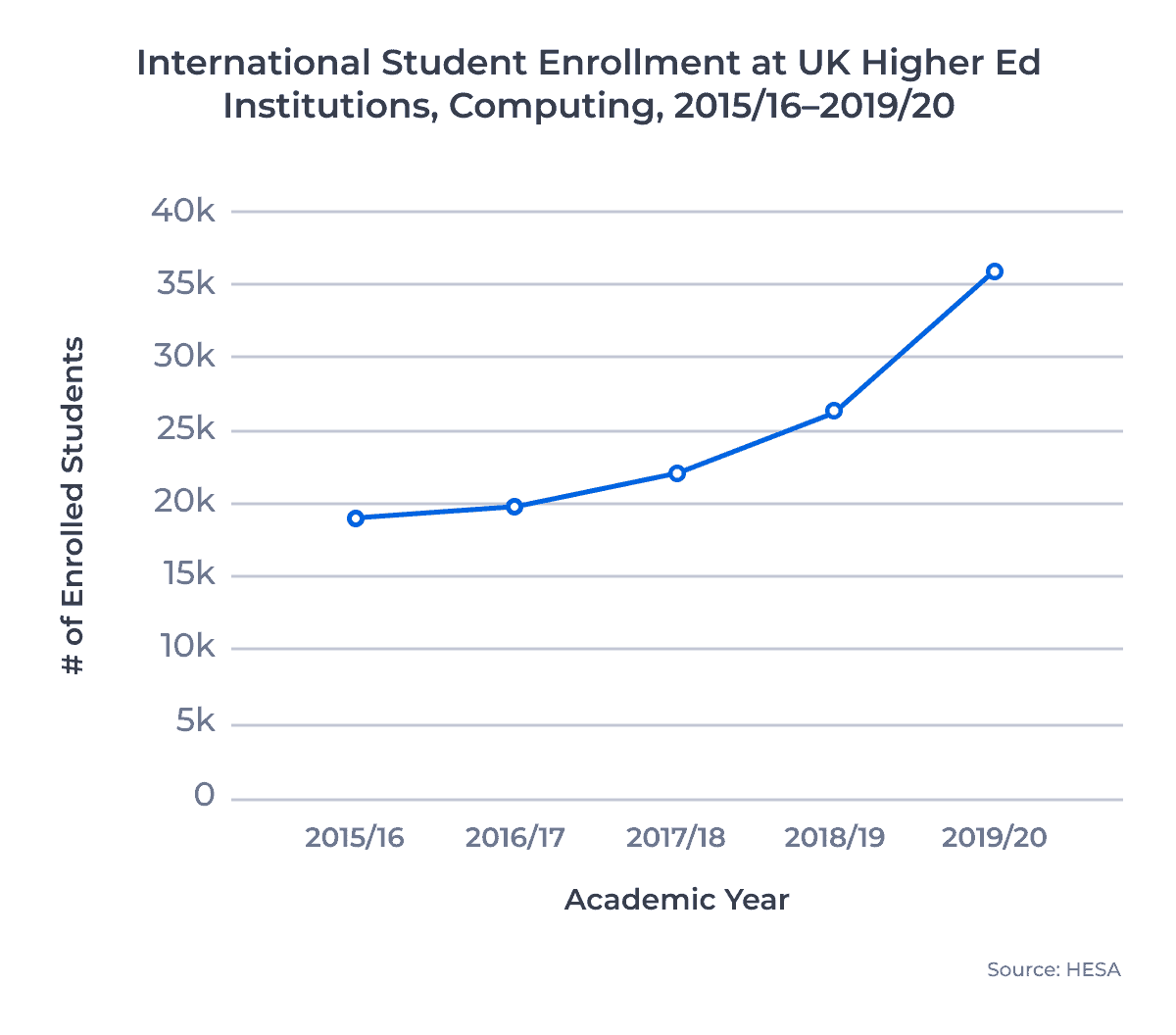Over the past few years, international students have become increasingly interested in business programs, especially in Canada. Many institutions also saw growing international student demand for health studies and medical programs, even before the pandemic. But another popular field of study accounted for as much as 20% of the international student population in major destination markets in 2020: information technology (IT) and computer science programs.
Here at ApplyBoard, we saw a major spike in student and recruitment partner searches for computer science programs through the ApplyBoard Platform in 2020. This is a strong indicator of future sector growth, especially since deciding on a field of study is the most important step for prospective international students.
In this ApplyInsights, I’ll be comparing the growth and popularity of IT and computer science programs among international students in Canada, the US, the UK, and Australia. I’ll take a look at how enrollment numbers in these programs changed through 2019 and 2020, and I’ll also discuss key student source markets for each destination market.
Key Insights at a Glance
- The number of new study permits issued for computing and IT programs at Canadian institutions grew by more than 50% from 2016 to 2019.
- IT was the most popular STEM field of study for international students enrolled at Australian tertiary institutions in 2020.
- 150,000+ international students were enrolled or working in computer and information science fields in the US in both 2018/19 and 2019/20.
- New international student enrollments for computing programs at UK institutions rose by nearly 50% from 2015/16 to 2019/20.
One important note: the available data varies between each destination market. For Canada and Australia, the data I’ll be analyzing is for new international student enrollments based on the calendar year. For the UK and the US, I’ll be analyzing the total number of international students enrolled in IT and computer studies programs based on academic year.
Let’s start with the Canadian market.
Canada
IT and computing passed applied and general science as the second most popular field of study in Canada1 for new international students in 2019. In the process, IT and computing became the top STEM2 field in Canada, a position that it maintained in 2020. In 2020, computing and IT programs accounted for nearly 15% of all new study permits issued.
In 2020, 3 of the top 10 Canadian university programs for ApplyBoard students were in IT and computing.
The chart below shows the number of new study permits issued to international students for computing and IT programs at Canadian institutions from 2016 to 2020:

The distribution of study permits for computing and IT between the college and university sectors has remained stable since 2016. From 2016 to 2020, university programs accounted for around 30% of new computing and IT study permits. This was slightly below the average for university programs among all fields of study, which ranged from 35 to 40% prior to 2020.
The following table shows the top student source markets for IT and computing programs at Canadian post-secondary institutions in 2019 and 2020:
| 2019 Rank | Source Market | 2020 Rank | Source Market |
|---|---|---|---|
| 1 | India | 1 (-) | India |
| 2 | China | 2 (↑) | France |
| 3 | France | 3 (↑) | Morocco |
| 4 | Bangladesh | 4 (↑) | Algeria |
| 5 | Iran | 5 (-) | Iran |
In 2019 and 2020, Indian students accounted for 67.4% of all new study permits issued for IT and computing studies. The other top five markets combined accounted for only around 11.0% of all such study permits in 2019 and 2020. In 2020, Morocco and Algeria vaulted into the top five, largely due to the decline of the Chinese market. This collapse, coupled with the ongoing COVID-19 crisis in India, likely indicate that sector recovery won’t gain significant momentum until 2022.
Australia
Computing and IT programs are less popular among international students in Australia3 than they are in Canada. In 2020, IT programs accounted for only 11.5% of new international student enrollments4 at higher ed5 and VET6 institutions. However, like in Canada, IT was the top STEM field of study for international students in Australia in 2020.
The chart below shows the number of new international tertiary student enrollments for the five most popular fields of study in Australia in 2020:

The University of Melbourne, the Australian National University, and the University of Sydney all ranked within the top 50 universities for computer science worldwide in the QS 2020 Top Universities rankings.
The Australian tertiary education sector was hit hard by pandemic-related travel closures, and it’s likely that the number of new enrollments in IT studies will fall from 2020 to 2021. Despite this volatility, the primary source markets for new international IT and computing students remained stable between 2019 and 2020. The following table shows the top five source markets for new enrollments in Australian tertiary IT programs:
| 2019 Rank | Source Market | 2020 Rank | Source Market |
|---|---|---|---|
| 1 | India | 1 (-) | India |
| 2 | Nepal | 2 (↑) | China |
| 3 | China | 3 (↓) | Nepal |
| 4 | Pakistan | 4 (-) | Pakistan |
| 5 | Sri Lanka | 5 (-) | Sri Lanka |
China, India, and Nepal were the top three source markets for all new Australian student visas in 2019 and 2020. For IT studies, Indian students accounted for 31.0% of all new enrollments in both years, while Chinese students accounted for 22.6% and Nepalese students accounted for 20.5%. It’s likely that these source markets will remain critical to Australian tertiary IT studies in 2021 and beyond. However, Australian tertiary institutions should look to recruit from potential emerging source markets to ensure sector recovery post-pandemic.
United States
International students have shown a strong preference for STEM studies at US institutions in the past few years. In 2019/20, over 50% of international students were enrolled or working in STEM fields.7 Engineering was the most popular STEM field for international students in 2018/19 and 2019/20. But 14.7% of international students were enrolled or working in computer and information science programs in 2019/20, up from 14.3% in 2018/19.
The chart that follows shows the total number of international students enrolled at US institutions for the top five fields of study in 2018/19 and 2019/20:

According to THE’s 2020 World University Rankings, the US is home to six of the top ten best universities for computer science in the world.
The table below shows the top student source markets for mathematics and computer science programs8 at US institutions in 2018/19 and 2019/20:
| 2018/19 Rank | Source Market | 2019/20 Rank | Source Market |
|---|---|---|---|
| 1 | India | 1 (↑) | China |
| 2 | China | 2 (↓) | India |
| 3 | South Korea | 3 (-) | South Korea |
| 4 | Nepal | 4 (↑) | Vietnam |
| 5 | Saudi Arabia | 5 (↑) | Taiwan |
Over 70% of international students enrolled in mathematics and computer science came from either India or China in 2018/19 and 2019/20. Even though the 2019/20 academic year included the early stages of the pandemic, the number of math and computer science students from China rose by around 7% year-over-year. By contrast, Indian student numbers fell by about 10%. Student volumes from Nepal and Saudi Arabia dropped by over 13% from 2018/19 to 2019/20, while student populations from Vietnam and Taiwan climbed by more than 7%.
Applications for US institutions submitted through the ApplyBoard Platform surged in 2020, growing over 300% from April 2020 to April 2021.
United Kingdom
The UK is a growing international student destination market for computing studies.9 In the 2019/20 academic year, computing programs accounted for only 6.4% of total international student enrollments and 6.7% of new student enrollments. Despite these low totals, computing was the second-most popular STEM field for international students in 2019/20, behind Engineering.
The following chart shows the total number of international students enrolled at UK institutions for computing programs between 2015/16 and 2019/20:

The table below shows the top five source markets for new enrollments in UK computing programs:
| Rank | Source Market |
|---|---|
| 1 | China |
| 2 | India |
| 3 | Romania |
| 4 | Bulgaria |
| 5 | Nigeria |
Like most destination markets, China and India were the top student source markets for IT programs in the UK in 2018/19. However, there was also a strong Balkan student population and a growing Nigerian student market. While it’s likely that both the Indian and Chinese markets shrank somewhat in 2019/20, changes to student fees due to Brexit are predicted to shrink the EU international student market in the coming years. While the EU will remain an important source of new students, UK institutions should look to emerging markets such as Nigeria, India, and Bangladesh to grow their computing student populations post-pandemic.
Future Growth All But Guaranteed
International student interest in IT and computer studies programs is likely to continue to grow post-pandemic. The global shift to remote work has demonstrated a pressing need for IT service providers and employees. However, the demand for IT-trained employees in the workforce has outpaced graduation rates. LinkedIn estimated that over 150 million new technology jobs will be created globally in the next five years.
Computing and IT fields of study should be top of mind for international students looking to secure stable employment after they graduate. The US Bureau of Labor Statistics estimated that US employment in computer and IT occupations would grow by 11% from 2019 to 2029, a much faster growth rate than the average for all occupations. Likewise, the Government of Canada rated job prospects for many computing and IT-related positions as very strong in 2019 and beyond. And, in the CIPD Spring 2021 Labour Market Outlook, over two-thirds of UK survey respondents in the IT industry reported that they planned for significant hiring in 2021 and 2022.
To keep up with this booming global demand, institutions looking to recruit more international students for computing and IT programs should consider:
- Developing new, shorter-term programs focused on specific computing technologies and skill sets for growing industries such as health sciences, business analytics, and finance
- Increasing enrollment capacity for existing computing and IT programs and leveraging online and virtual curriculums to reach more students
- Promoting the career stability and opportunities provided by a computing or IT education
Published: June 2, 2021
Subscribe to ApplyInsights
Sign up for the latest insights on international education.
 Meti Basiri
Meti Basiri
Co-Founder and Chief Marketing Officer (CMO)
Meti is driven by the belief that education is a right, not a privilege. He leads the International Recruitment, Partner Relations, and Marketing teams at ApplyBoard, working to make education accessible to people around the world. Meti has been instrumental in building partnerships with 1,500+ educational institutions across Canada, the United, the United Kingdom, and Australia. Working with over 5,000 international recruitment partners, ApplyBoard has assisted over 150,000 students in their study abroad journey. Follow Meti on LinkedIn for more access to ApplyInsights and key industry trends.
FOOTNOTES:
1. Canadian statistics used in this article are for new study permits only. All such data courtesy of Immigration, Refugees and Citizenship Canada (IRCC).
2. Science, Technology, Engineering, and Mathematics.
3. All Australian data courtesy of the Australian Department of Education, Skills, and Employment (DESE).
4. Australian new international student enrollments do not reflect unique students as a student may enroll in more than one program over a given calendar year and thus be counted multiple times.
5. The higher education sector includes studies at Australian universities leading to the awarding of an associate’s degree, bachelor’s degree, graduate certificate, graduate diploma, coursework-based master’s degree, or higher education diploma/advanced diploma.
6. The Vocational Education and Training (VET) sector includes studies leading to the awarding of a VET diploma, advanced VET diploma, vocational graduate certificate, vocational graduate diploma, or certificate I-IV.
7. All US figures include undergraduate, graduate, and non-degree programs, as well as students enrolled in the Optional Practical Training (OPT) program. All enrollment numbers are calculated based on academic year. US data courtesy of the Institute of International Education (IIE).
8. Source market data for computer and information sciences only is not available.
9. All UK data is based on total enrollments per academic year. UK data courtesy of the Higher Education Statistics Agency (HESA).
10. Source market data for the UK market in 2019/20 is not yet available.



